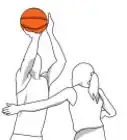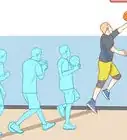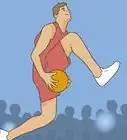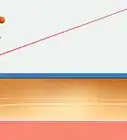This article was co-authored by Taylor Rochestie. Taylor Rochestie is a Professional Basketball Player, Author, and Speaker. Having lived in 12 countries, immersing himself in local cultures and learning about the diversity of life, Taylor offers a unique perspective through his book, "A New 20/20 Vision: Cultivate Joy, Reprogram Your Mind, and Define Life Through an Authentic Lens." He also has over 11 years of professional basketball experience with the Israel Basketball Premier League and the Montenegro men's national basketball team.
There are 7 references cited in this article, which can be found at the bottom of the page.
This article has been viewed 415,467 times.
Whether you're a pro NBA player or an amateur, there's nothing like the silky smooth "swish" of a jump shot that hits nothing but net. The act of shooting a jump shot is an art form when executed by masters like Wilt Chamberlain, Michael Jordan, Larry Bird, Hakeem Olajuwon, and many others. Like all basketball fundamentals, improving your jump shot is a matter of starting with basic fundamentals and building into advanced techniques with plenty of practice.
Steps
Shooting a Basic "J"
-
1First, pick a comfortable shooting location (many find it easiest to shoot from the free throw line, the elbows of the key on either side of it, or close to the hoop). Turn your body to face the hoop and plant your feet on the ground. Your feet should be turned towards your opposite hand about 10-45 degrees in order to align your hip, shoulder, and elbow with the basket.
- If you're just starting to learn how to make jump shots, begin by practising on your own — in other words, don't have a friend "cover" you until you've made a few shots on your own or it'll be hard to make progress.
-
2Get into a strong shooting stance. Believe it or not, the way you position your feet and lower body can have a big impact on your shooting accuracy even though you don't directly use them to shoot the ball.[1] Flex your knees slightly to give yourself the flexibility you'll need to power your jump.
- Shoulder-width or narrower foot positioning is important for your shooting speed and balance. Keep your feet closer together and you'll be fine. Keep them too wide apart and you won't be able to give your jump enough power or react quickly to changes on the field.[2]
- Keep your legs balanced and stable whenever you do a jump shot.[3]
Advertisement -
3Bring the ball into shooting position. Dip the ball to your shooting side waist or thigh. Spread your fingers and hold the ball with your fingertips to get as much control of the ball as possible. Position your shooting hand (the same one you write with) behind the ball so that the back of this hand faces directly away from the basket. Position your non-shooting hand on the side of the ball so that the thumb on this hand points toward your forehead.
- Your non-shooting hand is just as important for your shot as your shooting hand, so don't neglect it. Though it won't give your shot any power, it's largely responsible for shot control and balance. To see how important your non-shooting hand is, once you've gotten the hang of your jump shot, try shooting one-handed!
-
4Flex your knees, then jump! Push with your hips and legs to launch yourself into the air.
- For the greatest accuracy, as you flex, keep the forearm (ulna) aligned vertically, so that the hinged motion is always in line with the hoop. Think of shooting as a smooth hinged motion with your elbow as the hinge. Ideally, the forearm should be aligned pointing at the hoop. If your elbow moves out of alignment as you shoot, it will change the direction of the ball, so get in the habit of keeping it tucked in. In order to do this, turn your feet towards your opposite hand.
-
5Launch the ball. As you jump, bring the ball (which you should still be holding with proper hand placement) up in front of your body. Start to launch the ball up and toward the basket in an arc with your shooting arm only. Straighten your shooting arm elbow as you shoot, but keep it in line with your body.[4] Your non-shooting hand should only be used for keeping the ball under control and thus should stay on the side of the ball where it won't affect the path of the shot.
- Many coaches recommend looking at a certain part of the hoop as you make your shot. Some coaches recommend targeting the back of the hoop (especially for players who tend to under-shoot), others recommend the front of the hoop (especially for players who tend to over-shoot), and others coaches actually recommend visualizing the spot the ball will need to go for a "swish". The last option requires the most concentration, but some individuals claim that it achieves the best results.[5]
-
6Release and follow through. At the top of your jump, release the ball by turning your wrist downward.[6] The ball should roll off of your shooting hand, touching your index finger last. At this point, your shooting hand and arm should look roughly like you pinching your index finger and thumb together, with your other fingers higher. After you release the ball, let your shooting arm come down naturally, making sure you have turned your hips towards your opposite hand, landing with your feet pointed between 20 and 90 degrees towards your opposite hand.
- Try to get in the habit of releasing the ball at the top of your jump. Though you can make shots if you shoot earlier or later, doing so tends to make your shots jerky and inaccurate.[7] Also, releasing at the top of your jump gives you an advantageous shooting position — it's harder for defenders to block you when you're high in the air.
Increasing Your Versatility
-
1Start shooting from around the basket. In an actual game of basketball, obviously, you won't be able to shoot easy, direct jump shots from the free throw line or the wings all the time — it's the defense's job to prevent this. To begin to increase your versatility as a shooter, start to shoot from all over the court. You'll soon find that some shooting positions are much easier than others, but you'll only be an effective shooter if you're able to start hitting shots from all around the hoop, so practice these tricky shots!
- In general, you'll want to eventually be able to hit shots from anywhere inside the three point line and, ideally, just beyond it. You'll almost never be expected to shoot from more than a few feet behind the three point line during a game, so you don't have to worry as much about shooting these long-bomb shots. In order to shoot longer shots, jump forward further and turn more. This will give you more power.
- There are lots of different jump shots out there. Try to understand your own play style so you can practice the jump shots you're most likely to take in game.[8]
-
2Use the backboard for angled shots. Most of the time, the defense will try to deny you a direct, easy path to the basket. For this reason, you'll usually be shooting at the basket not from head-on, but from an angle. From angled positions, it's trickier to get a "swish" than when shooting from head-on, so most players try to bounce their shots off of the backboard. This slows the ball and angles it down into the basket, increasing the likelihood of an angled shot going in.
- Believe it or not, there has been actual scientific research done on this aspect of shooting a jump shot. The results indicate that the best angled shots tend to hit the backboard at a spot in the top middle section of the square behind the hoop. As the angle of the shot becomes more pronounced (that is, as a player shoots from further to one side), the "ideal" backboard spot moves up and away from this central point in a diagonal direction (in other words, someone shooting from the right side of the hoop should try to hit the backboard above and to the right of the top middle of the square). [9]
-
3Aim for the hoop for head-on shots. When you do get a chance to make a shot from straight in front of the basket, research shows that the benefits of using the backboard are less pronounced. In these cases, you may want to try to try for a "swish" (a shot that goes through the hoop without touching the rim or backboard). These can be tricky to make at first, but can become almost intuitive with frequent practice.
- One head-on shot you'll want to practice plenty is the one you make from the free throw line. Free throw shots are some of the only shots you'll get to take without being guarded by a defender, so it's important to practice to the point that you can make most of them. On average, NBA players tend to make about three-quarters of their free throws; for high school players, this statistic is closer to one-half.[10]
-
4Give your jump shots a healthy arc. When the ball approaches the hoop, the angle it's traveling at can have a big effect on how likely it is to go in. Steep-angled shots (those with high arcs) are, in theory, more likely to score points.[11] However, in reality, it's usually quite difficult for players to control high-arced shots. Thus, players looking to perfect their jump shot should try to aim for the perfectly-balanced shot — one with a medium-high arc that's still easy to control.
- Some basic research has been done on the effectiveness of various shooting arcs. Based on this research, the minimum arc for a shot to be able to make a "swish" shot is about 32o — with a regulation-size hoop and a men's ball, making a "swish" with this arc requires basically a perfect shot. On the other hand, high-arced shots (like, for instance, 55o) are very tough to control — even a tiny error can send the ball off-course.[12] From this research, a happy medium of about 45o seems preferable for most shooters.
-
5Practice your three point shot. A great three point jump shot is a huge asset to the team — if you're able to consistently sink shots from behind the line, the defense will have no choice but to guard you constantly, preventing at least one of their team members from covering the rest of the players. This means you'll want to spend plenty of time perfecting your three point shot. Three-pointers can be extra tricky — the additional power needed to get the ball to the hoop makes the shot harder to control — but they're worth the work.
- Don't forget to move around the court as you practice your three-pointer. Some of the hardest shots of all in basketball are three point shots from the side of the hoop. These shots force you to make a "swish", since you can't hit the backboard from this angle. If you can master these shots, you'll be a major shooting threat on the court.
-
6Practice with a partner to put pressure on you. No matter how much you practice alone, you can't replicate the experience of a defender trying to block your shot. Once you're fairly confident with basic jump shots, try getting a friend to guard you as you move around the court and take your shots. Remember, in a real game, it's the defense's job to make sure you never get an easy shot, so the more practice you get against actual players, the better.
- Shooting around a dogged defender can be seriously challenging — you'll need good dribbling and ball-handling skills to get your defender to slip up long enough for you to squeeze in a shot, so you may want to practice these skills separately.
Learning Advanced Techniques
-
1Try a pull-up jumper. Basketball can be a lightning-fast game. During a fast break, for instance, offensive players usually don't have time to stop moving, calmly line up their shot, and make it when they're ready — instead, they either have to drive straight to the hoop and go for a lay-up or make a jump shot immediately. When a player goes straight from running into making a jump shot in one fluid motion without any pause, this is called a "pull-up jumper". Once mastered, this skill is a valuable one, as it allows you to make shots from virtually anywhere around the basket without giving the defense any time to react.
- To make a pull-up jumper, start off by dribbling at a fast jog or run down the middle of the court. As you near the free throw line, flare out a few feet to the side. Come to a balanced stop in rhythm with your steps as you bring the ball up into both hands. Without hesitating, immediately get low, jump, and shoot. Practice until you can pull this move off quickly without stopping at any point.
-
2Try a turnaround jump shot. What do you do when you get the ball off of a pass and a defender is immediately right behind you, blocking your path to the hoop? One way to get out of this situation is to use a technique called a turnaround shot. In a turnaround shot, the player with the ball pretends to go one way, then spins in the opposite direction and shoots as soon as he's facing the hoop. Most of the time, this will give him a small window during which he can shoot without the defender blocking him.
- To shoot a turnaround shot, start with your back to the hoop and a defender guarding you closely from behind. Back towards the hoop as you dribble and stay low until you're a comfortable shooting distance away from it. Take a step in the direction of your throwing hand as you drop your non-shooting foot back slightly. Quickly pivot around on your non-shooting foot and make your jump shot immediately.
-
3Try a fadeaway shot. Many of the NBA's all-time greatest players had masterful fadeaway jump shots. As their name hints at, fadeaway shots are jump shots made when a player jumps and leans backward. This technique brings the ball away from the defender, giving the shooter extra room to shoot and making the shot very tough to guard against. However, it can be very hard to make fadeaway shots, so they're often seen as the mark of an excellent (or selfish) player.
- To make a fadeaway, start an ordinary jump shot or a turnaround shot as you normally would. As you jump, push yourself upward and backward, putting space between yourself and the player behind you. Lean back with your spine for extra space. Square up with the hoop in the air and hold the ball just above your head. When you reach the highest point of your jump, shoot the ball with a snapping motion of the wrist.
- Note that fadeaways require much more wrist strength than ordinary shots because much of the power from the legs that would ordinarily be used for the shot is spend propelling the shooter backwards.
-
4Try a pump fake. An important part of having a great jump shot is knowing when not to shoot. By carefully interspersing your shots with the occasional fakeout, you can keep defenders on their toes. More importantly, however, is the fact that a convincing fake can open up shooting opportunities when you're being guarded by a defender that just won't leave you alone.
- To make a pump fake, get low as you normally would just before taking a shot. Bring the ball up in front of you and prepare to jump. Start to rise up, but stop yourself just short of actually jumping. If your defender falls for your fake and jumps, either quickly dart around him or time your own jump so that you shoot just as he's hitting the ground to give yourself a free shot.
- It's important to stay in contact with the floor during your pump fake. Taking even a small hop without shooting constitutes an "up-and-down" penalty in basketball.
References
- ↑ http://www.humankinetics.com/excerpts/excerpts/a-proper-stance-increases-your-shooting-percentage
- ↑ http://www.humankinetics.com/excerpts/excerpts/a-proper-stance-increases-your-shooting-percentage
- ↑ Taylor Rochestie. Professional Basketball Player. Expert Interview. 13 July 2021.
- ↑ http://www.coachesclipboard.net/JumpShot.html
- ↑ http://www.coachesclipboard.net/JumpShot.html
- ↑ Taylor Rochestie. Professional Basketball Player. Expert Interview. 13 July 2021.
- ↑ http://www.breakthroughbasketball.com/fundamentals/shooting/5-shooting-mistakes.html
- ↑ Taylor Rochestie. Professional Basketball Player. Expert Interview. 13 July 2021.
- ↑ http://www.eurekalert.org/pub_releases/2011-03/ncsu-tpo031011.php
Expert Q&A
-
QuestionHow do you master the jump shot?
 Taylor RochestieTaylor Rochestie is a Professional Basketball Player, Author, and Speaker. Having lived in 12 countries, immersing himself in local cultures and learning about the diversity of life, Taylor offers a unique perspective through his book, "A New 20/20 Vision: Cultivate Joy, Reprogram Your Mind, and Define Life Through an Authentic Lens." He also has over 11 years of professional basketball experience with the Israel Basketball Premier League and the Montenegro men's national basketball team.
Taylor RochestieTaylor Rochestie is a Professional Basketball Player, Author, and Speaker. Having lived in 12 countries, immersing himself in local cultures and learning about the diversity of life, Taylor offers a unique perspective through his book, "A New 20/20 Vision: Cultivate Joy, Reprogram Your Mind, and Define Life Through an Authentic Lens." He also has over 11 years of professional basketball experience with the Israel Basketball Premier League and the Montenegro men's national basketball team.
Professional Basketball Player Repetition is your best friend. You should try to create good habits and attain stability through your legs, as a lot of the jump shot comes through them. Make sure you're stable and balanced in the legs.
Repetition is your best friend. You should try to create good habits and attain stability through your legs, as a lot of the jump shot comes through them. Make sure you're stable and balanced in the legs. -
QuestionWhat are the best practices to improve my jump shots?
 Taylor RochestieTaylor Rochestie is a Professional Basketball Player, Author, and Speaker. Having lived in 12 countries, immersing himself in local cultures and learning about the diversity of life, Taylor offers a unique perspective through his book, "A New 20/20 Vision: Cultivate Joy, Reprogram Your Mind, and Define Life Through an Authentic Lens." He also has over 11 years of professional basketball experience with the Israel Basketball Premier League and the Montenegro men's national basketball team.
Taylor RochestieTaylor Rochestie is a Professional Basketball Player, Author, and Speaker. Having lived in 12 countries, immersing himself in local cultures and learning about the diversity of life, Taylor offers a unique perspective through his book, "A New 20/20 Vision: Cultivate Joy, Reprogram Your Mind, and Define Life Through an Authentic Lens." He also has over 11 years of professional basketball experience with the Israel Basketball Premier League and the Montenegro men's national basketball team.
Professional Basketball Player Everybody has different things they focus on, as there are different types of jump shots. Do whatever you can to understand your game and understand what you bring to the team. And then try to do that in repetition in practice to bring that into the game.
Everybody has different things they focus on, as there are different types of jump shots. Do whatever you can to understand your game and understand what you bring to the team. And then try to do that in repetition in practice to bring that into the game. -
QuestionHow can I expand my shooting range?
 Community AnswerTo do this, you have to gain more power. Eat healthy, work out, and practice shooting farther everyday.
Community AnswerTo do this, you have to gain more power. Eat healthy, work out, and practice shooting farther everyday.
Warnings
- Don't think about anything but dropping the ball softly in the hoop with a smooth follow through. You hesitate when you think too much. This throws you off balance because your arms and legs stop working together in sync. Shoot like you are a real basketball player.⧼thumbs_response⧽
- Once you start bringing the ball up from its initial position just prior to release, it never travels back toward (or behind) your head. You may drain a couple of shots this way, but ultimately, it limits your range and regularity with which you make shots. Direction we are looking for is up, then, at the last moment, forward while following through.⧼thumbs_response⧽
- Follow through, but never force--regardless of your height, if it feels like you're just wailing the ball at the rim or the backboard: Stop! You're not doing it right and only hurting yourself. 70% of a good jump shot is muscle memory and proper form. Don't mess yours up intentionally.⧼thumbs_response⧽
- If you're serious, shoot 400-500 shots a day. Try to stay within 2 - 2 1/2 hours total time, but don't exhaust yourself initially. Build up so that it feels comfortable (otherwise, you're wasting your time--your muscles are not "learning"; when you're exhausted, you're in survival mode). You can break up the shots in 2 sessions.⧼thumbs_response⧽
Things You'll Need
- Basketball
- Basketball Net
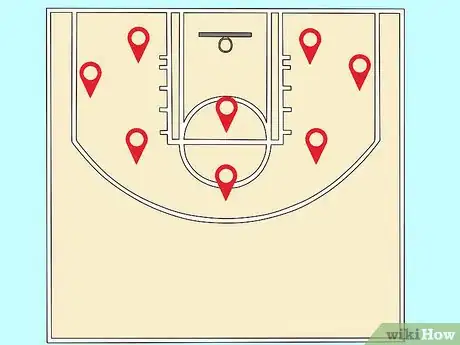
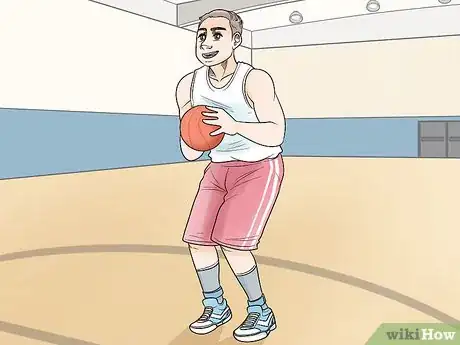

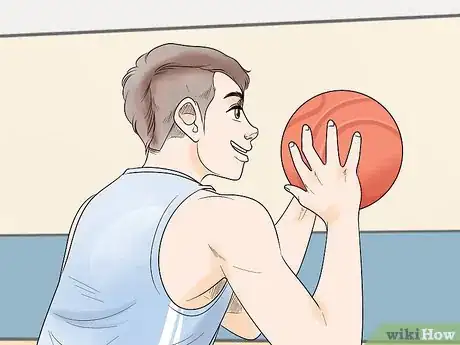
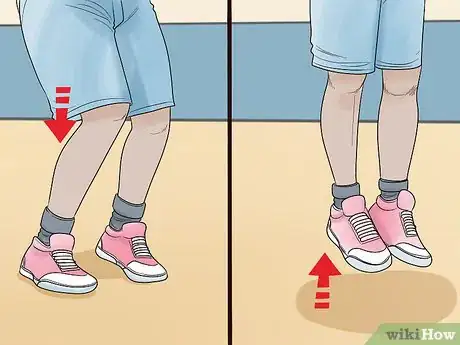
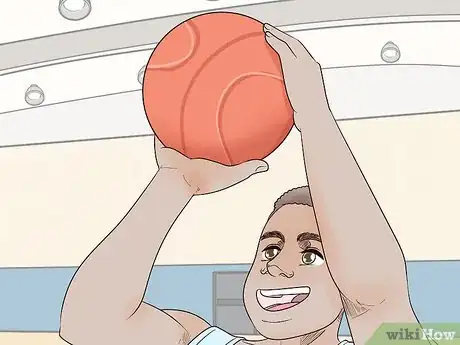

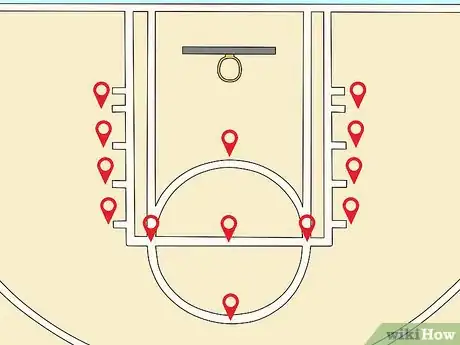

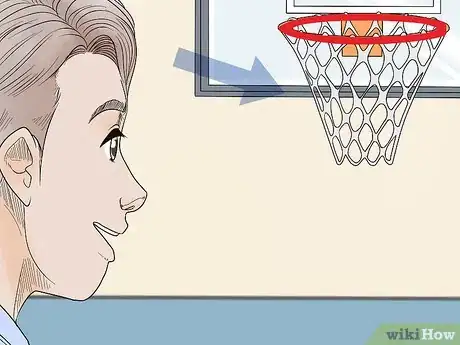
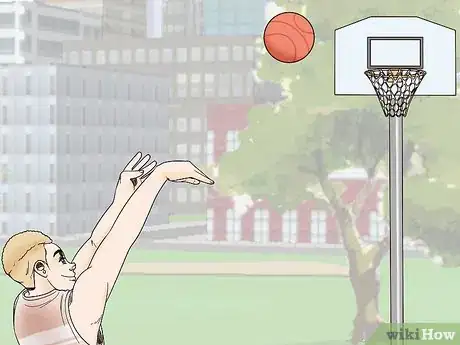
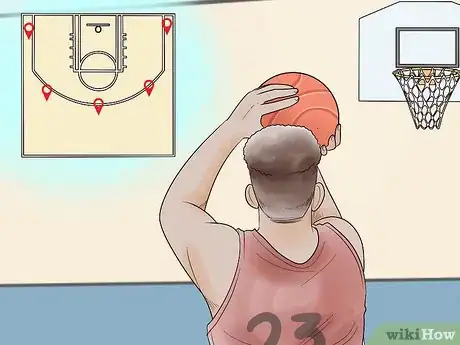
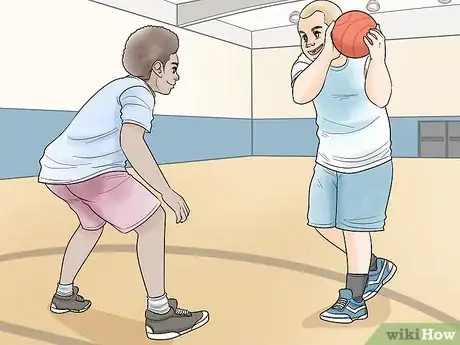
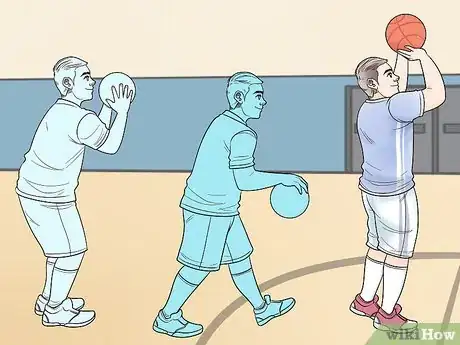
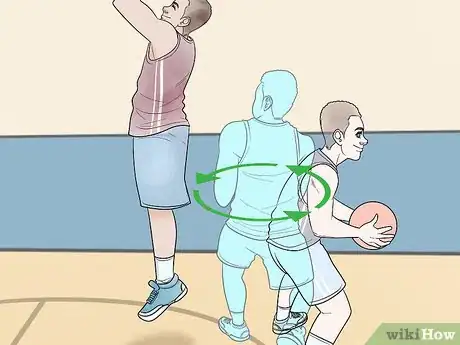
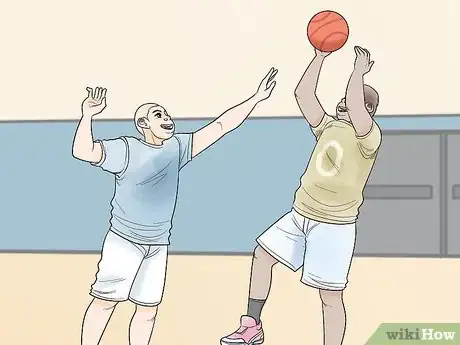

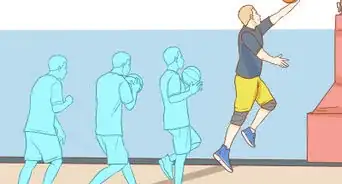
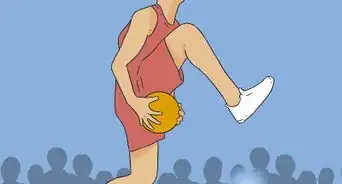
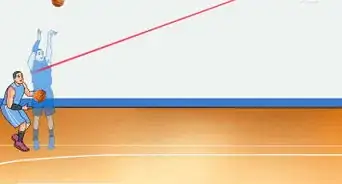
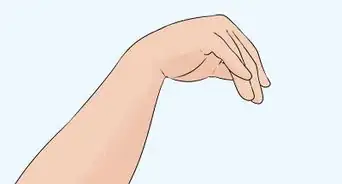
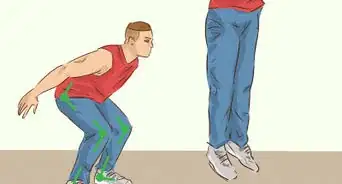
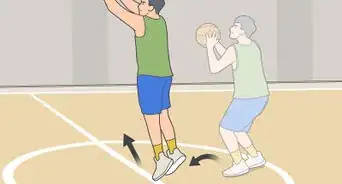
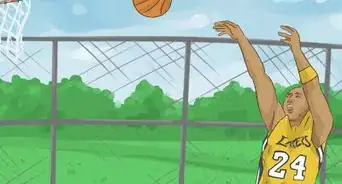
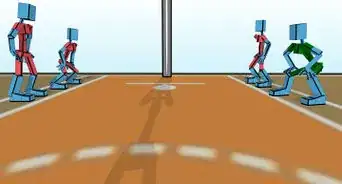
-Step-13.webp)








